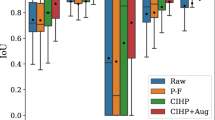Abstract
Regional neuraxial analgesia is a safe method for pain relief during labor, but its effectiveness must be assessed carefully. As a non-invasive technique, thermal imaging is gaining increasing acclaim as an objective way to quantify blood flow redistribution-related warm modifications. Hence, thermal measurements are acquired under controlled conditions at different timestamps to determine the anesthesia depth by characterizing earlier thermal changes. However, the procedures during labor are limited by two main factors: a relatively small sample size is possible and thermal images cannot be acquired with both feet in the same position. This work implements an automatic semantic segmentation approach using five state-of-the-art deep learning architectures and an artifact removal algorithm based on morphological operators to deal with this problem. The obtained results are evaluated on two databases (acquired at the Universidad Nacional de Colombia sede Manizales and the SES Hospital Universitario de Caldas): controlled and uncontrolled environments for thermal data acquisition. Obtained results indicate that U-Mobilenetv2 approach outperforms the rest of the compared models.
Access this chapter
Tax calculation will be finalised at checkout
Purchases are for personal use only
Similar content being viewed by others
Notes
References
Arteaga-Marrero, N., Hernández, A., Villa, E., González-Pérez, S., Luque, C., Ruiz-Alzola, J.: Segmentation approaches for diabetic foot disorders. Sensors 21(3) (2021). https://doi.org/10.3390/s21030934
Badrinarayanan, V., Kendall, A., Cipolla, R.: Segnet: a deep convolutional encoder-decoder architecture for image segmentation. IEEE Trans. Pattern Anal. Mach. Intell. 39(12), 2481–2495 (2017). https://doi.org/10.1109/TPAMI.2016.2644615
Bouallal, D., Bougrine, A., Douzi, H., Harba, R., Canals, R., Vilcahuaman, L., Arbanil, H.: Segmentation of plantar foot thermal images: application to diabetic foot diagnosis. In: 2020 International Conference on Systems, Signals and Image Processing (IWSSIP), pp. 116–121 (2020). https://doi.org/10.1109/IWSSIP48289.2020.9145167
Bougrine, A., Harba, R., Canals, R., Lédée, R., Jabloun, M.: On the segmentation of plantar foot thermal images with deep learning. In: 2019 27th European Signal Processing Conference (EUSIPCO), pp. 1–5 (2019)
Brown, D.T., Wildsmith, J.A.W., Covino, B.G., Scott, D.B.: Effect of Baricity on Spinal Anaesthesia with Amethocaine. BJA: British J. Anaesthesia 52(6), 589–596 (1980). https://doi.org/10.1093/bja/52.6.589
Bruins, A.A., Kistemaker, K.R.J., Boom, A., Klaessens, J., Verdaasdonk, R., Boer, C.: Thermographic skin temperature measurement compared with cold sensation in predicting the efficacy and distribution of epidural anesthesia. J. Clin. Monit. Comput. 32, 335–341 (2018)
Géron, A.: Hands-on machine learning with Scikit-Learn, Keras, and TensorFlow: Concepts, tools, and techniques to build intelligent systems. O’Reilly Media, Inc. (2019)
Haren, F., Kadic, L., Driessen, J.: Skin temperature measured by infrared thermography after ultrasound-guided blockade of the sciatic nerve. Acta anaesthesiologica Scandinavica 57, August 2013. https://doi.org/10.1111/aas.12170
He, Y., et al.: Infrared machine vision and infrared thermography with deep learning: a review. Infrared Phys. Technol. 116, 103754 (2021). https://doi.org/10.1016/j.infrared.2021.103754. https://www.sciencedirect.com/science/article/pii/S1350449521001262
Howard, A.G., et al.: Mobilenets: efficient convolutional neural networks for mobile vision applications. CoRR abs/1704.04861 (2017). http://arxiv.org/abs/1704.04861
Jimenez-Castaño, C.A., Álvarez-Meza, A.M., Aguirre-Ospina, O.D., Cárdenas-Peña, D.A., Orozco-Gutiérrez, Á.A.: Random fourier features-based deep learning improvement with class activation interpretability for nerve structure segmentation. Sensors 21(22), 7741 (2021)
Krizhevsky, A., Sutskever, I., Hinton, G.E.: Imagenet classification with deep convolutional neural networks. In: Pereira, F., Burges, C.J.C., Bottou, L., Weinberger, K.Q. (eds.) Advances in Neural Information Processing Systems, vol. 25. Curran Associates, Inc. (2012). https://proceedings.neurips.cc/paper/2012/file/c399862d3b9d6b76c8436e924a68c45b-Paper.pdf
Long, J., Shelhamer, E., Darrell, T.: Fully convolutional networks for semantic segmentation (2015)
Morid, M.A., Borjali, A., Del Fiol, G.: A scoping review of transfer learning research on medical image analysis using imagenet. Comput. Biol. Med. 128, 104115 (2021)
Ronneberger, O., Fischer, P., Brox, T.: U-net: Convolutional networks for biomedical image segmentation. CoRR abs/1505.04597 (2015). http://arxiv.org/abs/1505.04597
Simonyan, K., Zisserman, A.: Very deep convolutional networks for large-scale image recognition (2015)
Szegedy, C., et al.: Going deeper with convolutions. CoRR abs/1409.4842 (2014). http://arxiv.org/abs/1409.4842
Vardasca, R., Magalhaes, C., Mendes, J.: Biomedical applications of infrared thermal imaging: current state of machine learning classification. Proceedings 27(1) (2019). https://doi.org/10.3390/proceedings2019027046. https://www.mdpi.com/2504-3900/27/1/46
Acknowledgements
Under grants provided by the Minciencias’s project: “Herramienta de apoyo a la predicción de los efectos de anestéticos locales vía neuroaxial epidural a partir de termografía por infrarrojo" code 111984468021.
Author information
Authors and Affiliations
Corresponding author
Editor information
Editors and Affiliations
Rights and permissions
Copyright information
© 2022 The Author(s), under exclusive license to Springer Nature Switzerland AG
About this paper
Cite this paper
Mejia-Zuluaga, R. et al. (2022). Deep Learning Semantic Segmentation of Feet Using Infrared Thermal Images. In: Bicharra Garcia, A.C., Ferro, M., Rodríguez Ribón, J.C. (eds) Advances in Artificial Intelligence – IBERAMIA 2022. IBERAMIA 2022. Lecture Notes in Computer Science(), vol 13788. Springer, Cham. https://doi.org/10.1007/978-3-031-22419-5_29
Download citation
DOI: https://doi.org/10.1007/978-3-031-22419-5_29
Published:
Publisher Name: Springer, Cham
Print ISBN: 978-3-031-22418-8
Online ISBN: 978-3-031-22419-5
eBook Packages: Computer ScienceComputer Science (R0)




